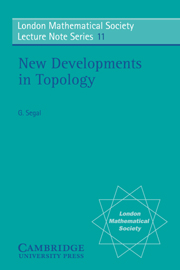Book contents
- Frontmatter
- Contents
- Preface
- 1 Operations of the nth kind in K-theory, and what we don't know about RP∞
- 2 The Pontrjagin dual of a spectrum
- 3 Algebraic K-theory of non-additive functors of finite degree
- 4 Dyer-Lashof operations in K-theory
- 5 Homotopy homomorphisms of Lie groups
- 6 On spherical fiber bundles and their PL reductions
- 7 E∞ spaces, group completions, and permutative categories
- 8 Higher K-theory for categories with exact sequences
- 9 Operations in stable homotopy theory
- 10 Equivariant algebraic K-theory
- 11 On rank 2 mod odd H-spaces
6 - On spherical fiber bundles and their PL reductions
Published online by Cambridge University Press: 05 April 2013
- Frontmatter
- Contents
- Preface
- 1 Operations of the nth kind in K-theory, and what we don't know about RP∞
- 2 The Pontrjagin dual of a spectrum
- 3 Algebraic K-theory of non-additive functors of finite degree
- 4 Dyer-Lashof operations in K-theory
- 5 Homotopy homomorphisms of Lie groups
- 6 On spherical fiber bundles and their PL reductions
- 7 E∞ spaces, group completions, and permutative categories
- 8 Higher K-theory for categories with exact sequences
- 9 Operations in stable homotopy theory
- 10 Equivariant algebraic K-theory
- 11 On rank 2 mod odd H-spaces
Summary
Twenty years ago, Borel, Bott, Hirzebruch, Milnor, and Thorn, among others, studied the structure of the classifying spaces for the orthogonal and unitary groups. From their work, it became clear that the classifying spaces BPL, BTOP, and BG (BG is the classifying space for fiber homotopy sphere bundles [14], [20]) contained the answers to many of the problems they raised.
The last ten years have seen a concerted effort to understand these spaces, and the path has been highlighted by several beautiful results: Sullivan' s work on G/PL and related spaces leading to the Hauptvermutung for 4-connected manifolds ([18], [21]), Novikov's work on the invariance of the rational Pontrjagin classes ([15]), the work of Kirby-Siebenmann and Lashof-Rothenberg on G/TOP and the triangulation theorem ([7], [9]), and the work of Quill en-Sullivan on the Adams conjecture ([16], [22]).
Recently, in joint work with Brumfiel, we have determined the mod 2 cohomology of BPL. and BTOP ([3]). This of course gave the algebraic determination of the unoriented PL-bordism ring and, except in dimension 4, the topological bordism ring.
Here we almost complete the analysis of the structure of H*(BPL) at the prime 2. In particular, at the prime 2, we determine the obstructions to reducing the structure ‘group’ of a fiber homotopy sphere bundle to TOP or PL. As an application, using the Browder-Novikov theorem, these obstructions determine explicit conditions on a simple-connected Poinc are -duality space, which imply that it has the (2-local) homotopy type of a topological or PL-manifold.
- Type
- Chapter
- Information
- New Developments in Topology , pp. 43 - 60Publisher: Cambridge University PressPrint publication year: 1974
- 6
- Cited by



